Spain: Years of promises at Camp Nou – every mistake made by Laporta
source: StadiumDB.com; author: Jakub Ducki
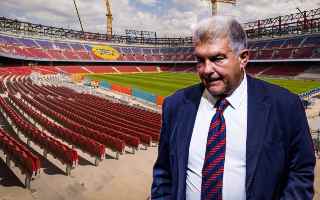 From the very beginning, the redevelopment of Camp Nou took shape as a never-ending story. Although FC Barcelona repeatedly announced their return to the stadium, each new chapter of this saga ended in a broken promise. What did this journey look like from the very start?
From the very beginning, the redevelopment of Camp Nou took shape as a never-ending story. Although FC Barcelona repeatedly announced their return to the stadium, each new chapter of this saga ended in a broken promise. What did this journey look like from the very start?
Advertisement
Everything under control – at first
In early May 2022, Joan Laporta announced what fans had been waiting for over the years: the redevelopment of Camp Nou would begin in June. The plan was ambitious but specific – during the 2022/23 season, works were to proceed without completely taking the stadium out of use, and only from the following season would the team temporarily move to Estadi Olímpic Lluís Companys. The return to Camp Nou was scheduled for the 2024/25 campaign, with access to half of the stands, while the full completion of the renovation was planned for the 2025/26 season.
The project was impressive: 105,000 seats, a roof with an integrated 360-degree screen, expanded VIP areas, green technologies, and new public space around the stadium. The entire venture was expected to cost €1.5 billion but projected to pay off by bringing the club up to €200 million annually.
However, less than three months later, the first change of plans was announced. At the end of July 2022, Barcelona’s management revealed that they would use the break in league fixtures caused by the winter World Cup in Qatar to demolish part of the Gol Sud. Originally, these works were scheduled to take place during the 2023/24 season.
The change was presented as an acceleration of the timeline – the club wanted to begin laying the foundations for new structures already in 2022 to be better prepared for the main phase of the renovation. At the same time, they began dismantling seats, tech installations, protective nets, and food service infrastructure.
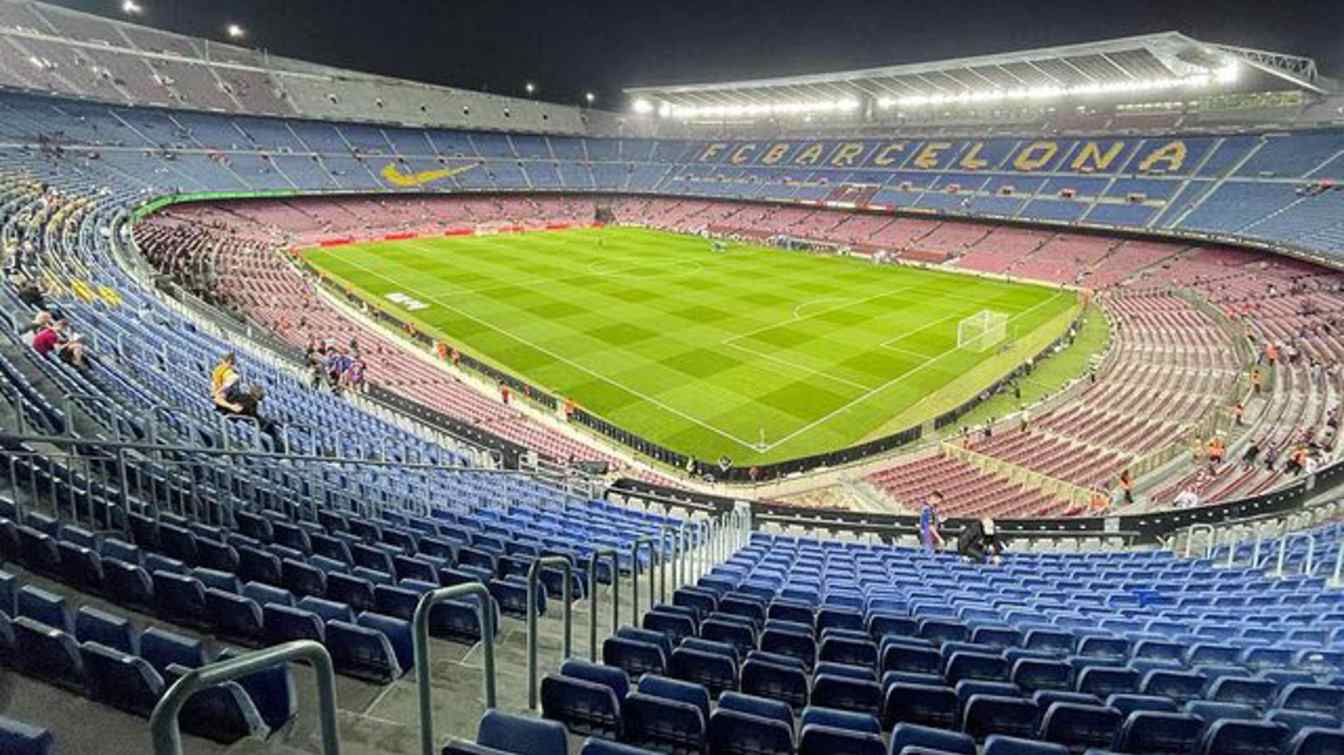 © Petra Vosáhlová | Spotify Camp Nou (23.10.2022)
© Petra Vosáhlová | Spotify Camp Nou (23.10.2022)
Symbolic date, tough questions, and first cracks
In January 2023, Barcelona made a key announcement – the general contractor for the Camp Nou redevelopment would be the Turkish company Limak Construction. The choice immediately sparked controversy. The company was known for building Istanbul’s airport and several major civil projects, but its experience in stadium construction was limited to a single venue – a 25,000-seat stadium in Mersin.
Vice president Elena Fort assured the public that the selection followed a thorough five-stage tender process and that Limak had the backing of the project architects. At the same time, a new timeline was presented: works were to begin in June 2023, and FC Barcelona was to return to Camp Nou on November 29, 2024, to celebrate the club’s 125th anniversary. The stadium would then be fully completed in June 2026.
The symbolic return date became a new point of reference – and at the same time, the first sign of a shifting schedule. But already in March 2023, Laporta had to face another problem – financing. The plan to issue €1.5 billion in green bonds to fund the Espai Barça project met resistance from investors.
At the same time, the club was dealing with yet another crisis – the so-called Caso Negreira
scandal. An investigation into suspicious payments made to the vice president of the referees' committee was ongoing, and formal charges had been filed against the club. Although it was not yet clear how severely the case would affect Barça’s future, the atmosphere surrounding the redevelopment was clearly deteriorating.
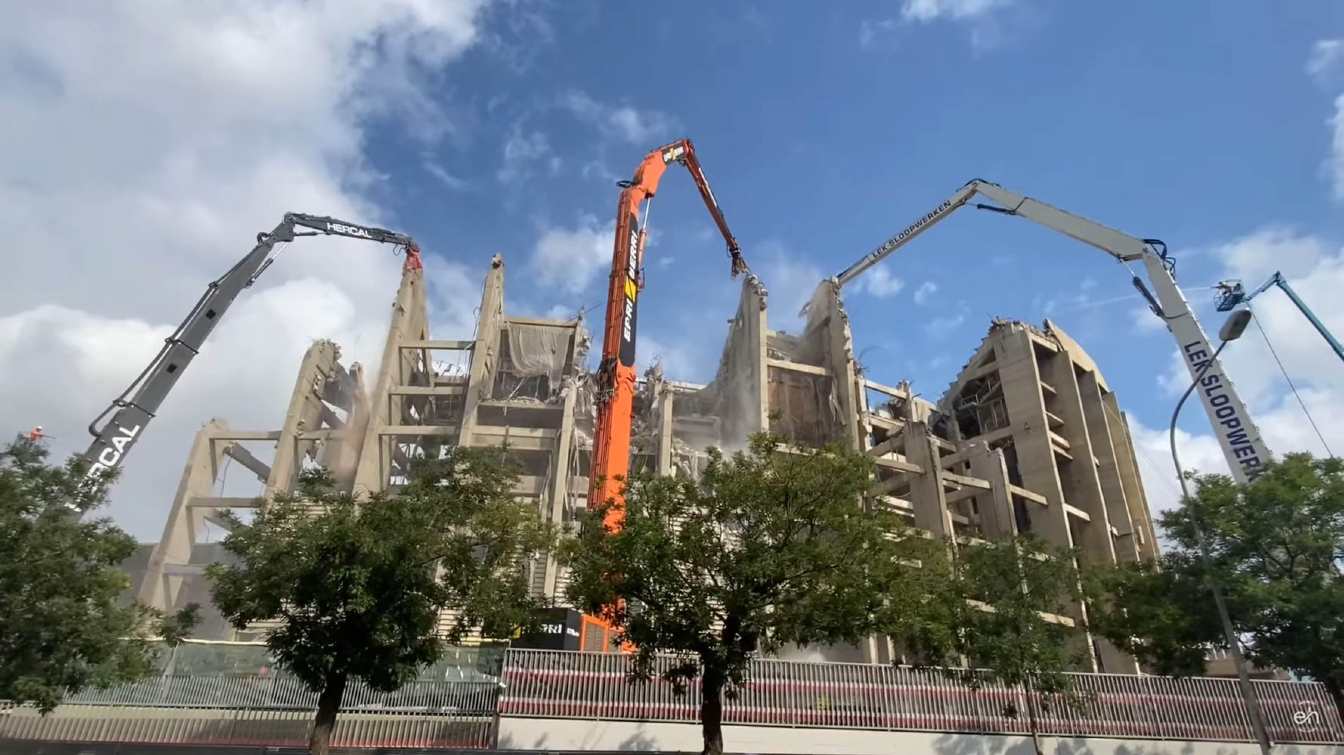 © Espai Héctor | Spotify Camp Nou (05.07.2023)
© Espai Héctor | Spotify Camp Nou (05.07.2023)
Gap between plans and reality
The year 2024 was supposed to be a breakthrough for Barcelona – marking a return to Camp Nou on the symbolic 125th anniversary of the club and showcasing visible progress on the construction site. At first, everything suggested the goal was within reach. Construction of the new stand was progressing, the number of workers was increasing, and the club boasted about eco-friendly solutions and new technology partnerships.
Over time, however, optimism gave way to uncertainty. The originally planned return in November was pushed to December, then January, until voices emerged suggesting that a realistic return might not happen before spring 2025. The club did not confirm this publicly, but Laporta began referring to the end of the year
without specifying a concrete date.
At the same time, controversies around working conditions began to mount. Inspections revealed irregularities among many subcontractors – unpaid wages, missing social security contributions, and the exploitation of foreign laborers. The situation was further inflamed by Laporta’s statements accusing the media of bias, which drew criticism from local institutions.
In the background, the fight to regain financial momentum continued. The club was lobbying La Liga for a favorable schedule and planning a partial return to Camp Nou before the end of the year – with reduced capacity and a new seat allocation system for socios.
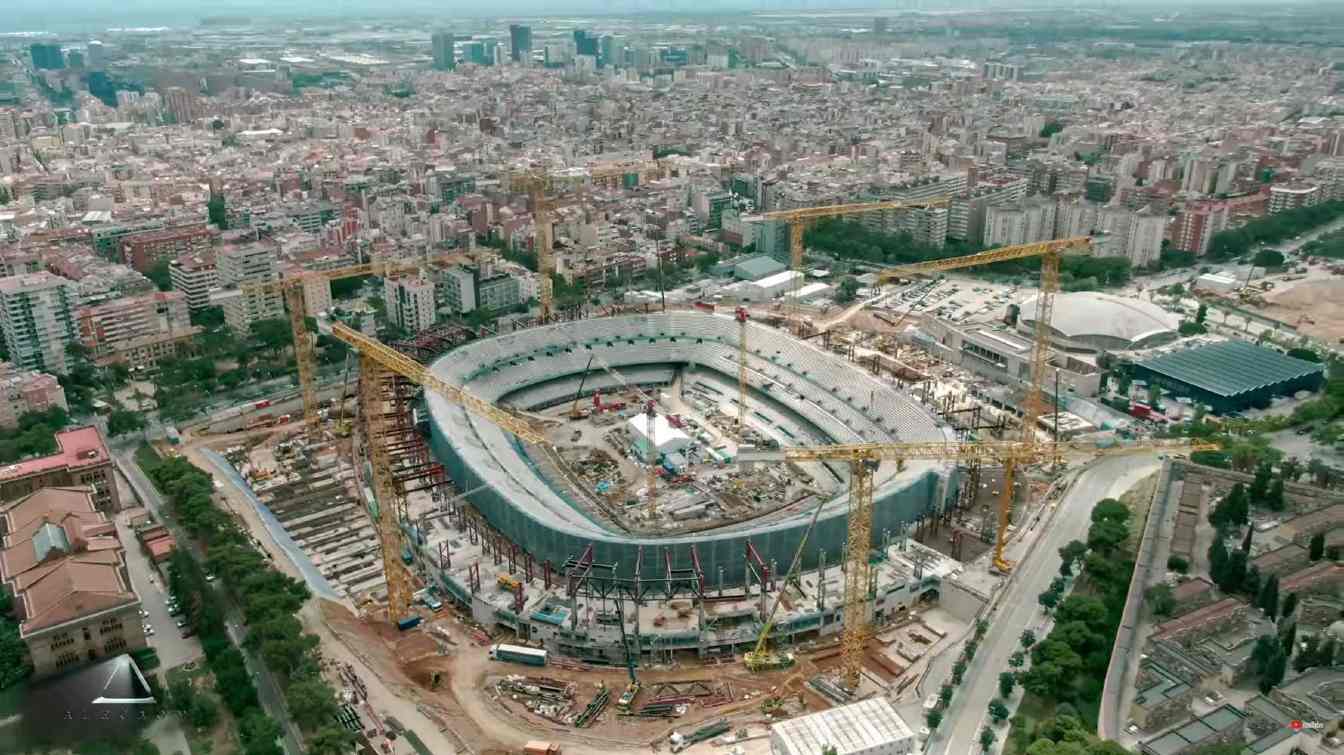 © Alecaom | Spotify Camp Nou (07.07.2024)
© Alecaom | Spotify Camp Nou (07.07.2024)
Return in second half of season?
By autumn 2024, the wait for a return to Camp Nou began to feel like chasing a vanishing target. Official statements still mentioned the end of the year
or second half of the season,
but the reality on-site told a different story. The absence of stands, pitch, and roof raised doubts about even the January timeline. Reports emerged suggesting a realistic date might be April 2025, although the club did not confirm them.
Joan Laporta tried to maintain optimism, avoiding specific dates. The club steered clear of firm commitments, emphasizing that the timeline could change and that the return would take place as soon as conditions allow
– as the president put it in one of his statements. At the same time, the construction schedule was adjusted – work on the roof was postponed in order to focus on the minimum infrastructure necessary to host matches.
Fans found hope in small signals: the installation of the first seats, visible progress on certain stands, new partnerships with Aramark and HP Enterprise, and the symbolic opening of the Mirador de las Obras
viewing platform. But as December approached, it became increasingly clear that the stadium would not be ready in time for the anniversary or the holidays.
Behind the scenes, the financial pressure was mounting. Playing at Montjuïc was generating tens of millions in losses, and La Liga had to adapt the calendar to maximize revenue from a possible return to Camp Nou. Finally, in early October, the club admitted it openly: the return would take place in the second half of the season, most likely in January or February 2025.
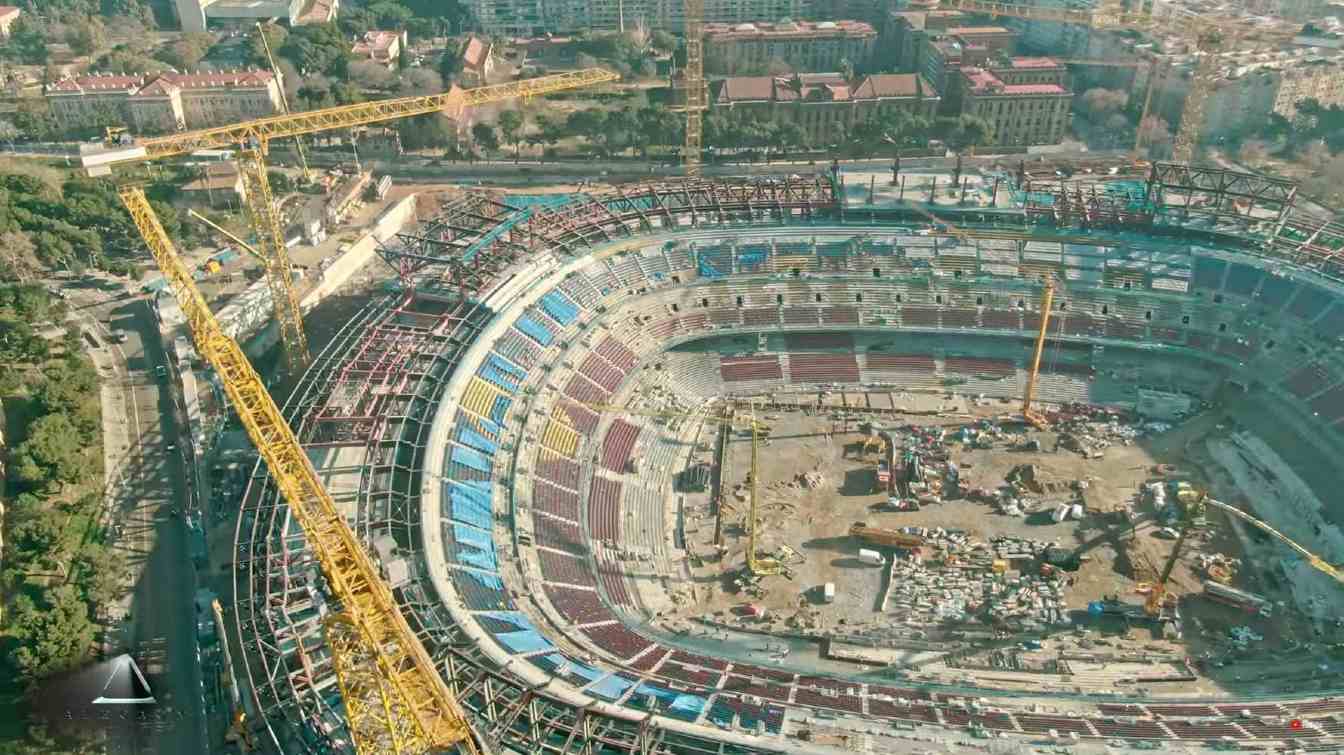 © Alecaom | Spotify Camp Nou (24.01.2025)
© Alecaom | Spotify Camp Nou (24.01.2025)
Month by month, decision by decision
By autumn 2024, FC Barcelona’s declarations were becoming increasingly meaningless. In official statements by Joan Laporta and Elena Fort, multiple new return dates to Camp Nou were floated: December, early January, then the turn of January and February. Eventually, however, comments from club officials and city representatives suggested that the first possible match could only take place in the second half of February – with Rayo Vallecano as the earliest likely opponent.
Meanwhile, the site was still filled with containers and machinery, and the pitch wasn’t even ready for initial preparations. Relevo estimated that preparing the field alone would take two months. The most pessimistic scenarios were already pointing to the 2025/26 season. Laporta continued to speak of a permanent return,
although behind the scenes, new information contradicted that narrative – including the extension of the rental agreement for the Olympic stadium until the end of the season and a declaration from the public municipal company (BSM) that Montjuïc would no longer be available to Barça after May 1.
Disappointment, resignation, and a Plan B
In early December 2024, the club officially stopped pretending that the return to Camp Nou would happen before the end of the year.
November 29 – initially designated as the symbolic date for completing the first phase – came and went, and the stadium was still in a raw, unfinished state. What’s more, despite the contract with Limak including a €1 million penalty for each day of delay, the club’s board decided not to enforce that clause. Officially – due to the good cooperation
and the risk of further delays.
At the same time, work did not accelerate. By mid-December, the club was increasingly signaling that even a March return might be unrealistic. UEFA regulations require that all matches in a Champions League round be played at the same stadium, so even if Camp Nou was ready just in time, hosting a match on March 11 could still be impossible. To make matters worse, key infrastructure such as evacuation routes and VIP boxes remained unfinished.
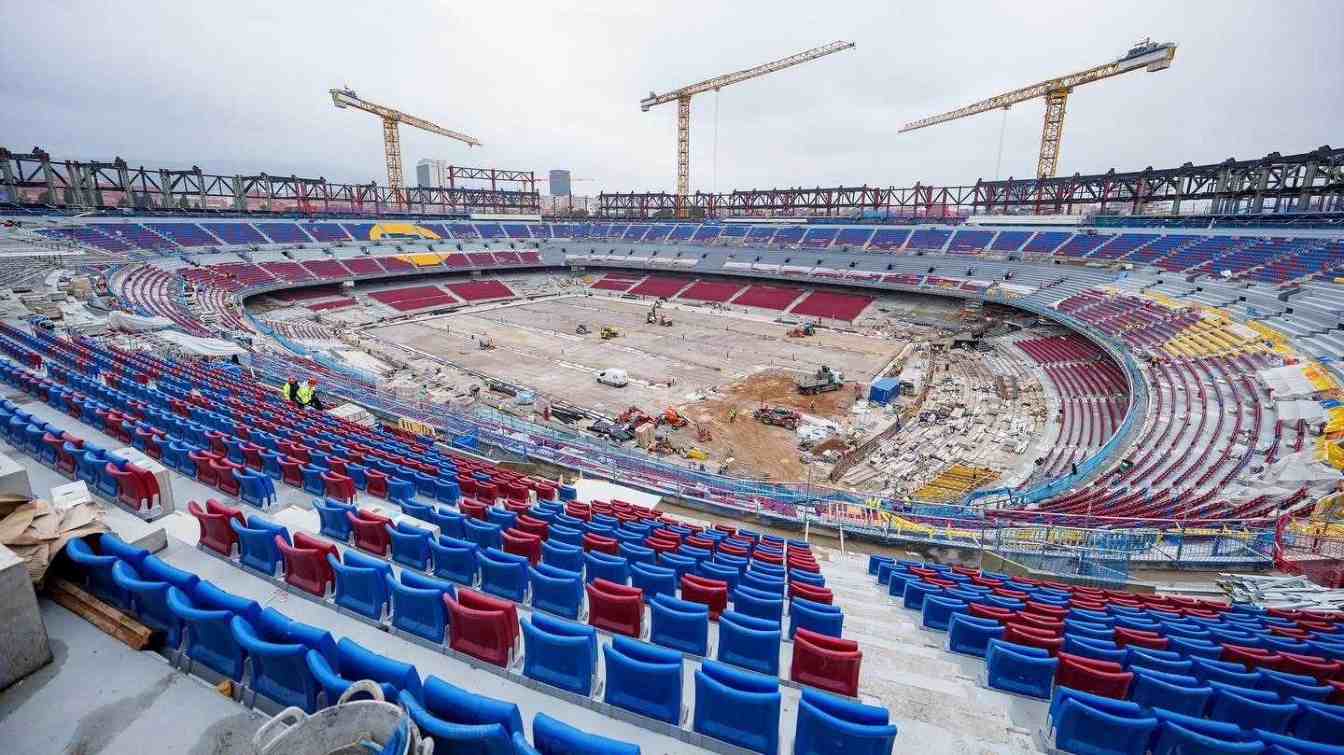 © FC Barcelona | Spotify Camp Nou (07.03.2025)
© FC Barcelona | Spotify Camp Nou (07.03.2025)
Behind the scenes, the search for an alternative was ongoing. Montjuïc was booked for spring and summer concerts, so the club entered negotiations with the City Council and began preparing a contingency plan. The most realistic option – although politically hard to accept – appeared to be Espanyol’s stadium in Cornellà.
In this atmosphere, Laporta was no longer giving specific dates. Instead, he spoke of a return sooner rather than later,
while emphasizing the importance of complying with UEFA regulations. Publicly, the club continued to speak of the largest investment in Southern Europe,
but behind the scenes, preparations were underway for a scenario in which Camp Nou might not be available even by September 2025.
Increasingly hard to believe in quick return
At the beginning of 2025, FC Barcelona applied to extend their agreement to use Montjuïc until the end of April, hoping to complete the works at Camp Nou in May. The key date was supposed to be May 11 – the day of El Clásico. Meanwhile, discussions were ongoing with city officials, who planned to begin preparations for summer concerts as early as May.
Despite efforts, the situation continued to grow more complicated. Although the stadium was expected to accommodate 63,000 spectators in the spring, not all permits had been secured. Turf installation only began in mid-March, and final completion still required approval from the fire department and LaLiga.
During this period, concerns about the following season were also mounting. The club planned to start the 2025/26 campaign with away matches, but roof installation – which required the stadium to be completely closed for three months – was postponed until the summer of 2026. As a result, the plan to partially reopen the stadium in the spring was abandoned.
More and more sources were indicating a possible return in autumn 2025, and unofficially even in November. The club denied these reports, but at the same time admitted that the third tier would not be completed before the 2026/27 season. Meanwhile, the sale of season tickets for spring 2025 matches turned out to be premature.
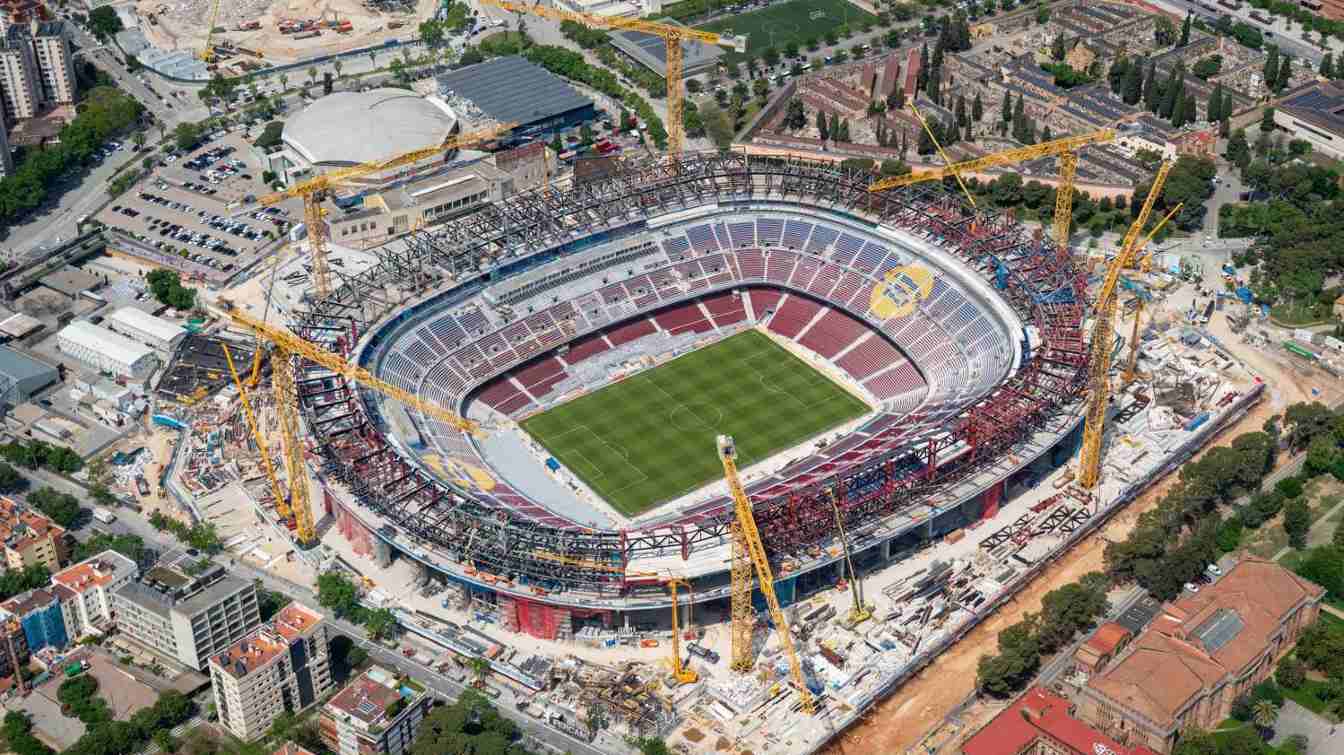 © FC Barcelona | Spotify Camp Nou (28.05.2025)
© FC Barcelona | Spotify Camp Nou (28.05.2025)
New target: September, but first a test
In April 2025, Laporta, accompanied by representatives from Limak, visited the construction site, highlighting the acceleration of works and the planned return to Camp Nou in September. To make this possible, the decision was made to delay roof installation until 2026. Although the turf had been seeded and photos published, there were no plans yet to use it – the grass was expected to mature over the coming months.
The new key date became September 16 – the start of the UEFA Champions League group stage. UEFA regulations require that all matches in this phase be played at the same stadium, so Barça planned to complete all essential works before that deadline. Construction continued around the clock to meet the target.
For the 2025/26 season, a reduced stadium capacity was planned – between 60,000 and 65,000 seats. The club announced the continuation of a rotating season ticket system, modeled on the approach used at Montjuïc, and the organization of a test friendly match with volunteers during the summer.
Despite the club’s optimism, the mayor of Barcelona declined to confirm any specific return date, stressing the need for further coordination. Laporta, however, assured that the Joan Gamper Trophy would already be held at Camp Nou – on August 9 or 10 – and would serve as the final rehearsal before the official return in mid-September.
Return announced. But is everything really ready?
In early June 2025, Barcelona received approval from La Liga to start the season with four away games, buying time to finish construction. The official return to Camp Nou was scheduled for the fifth matchday, in mid-September. Before that, on August 9 or 10, the Joan Gamper Trophy match would be held with 25,000 spectators – serving as a test of the stadium’s infrastructure.
Photos of the pitch published in the spring, showing clearly marked lines, turned out to be part of a PR strategy – the grass had only been planted to give the impression of progress. In reality, it was a temporary turf that was set to be removed before the next phase of construction could begin.
In June, FC Barcelona initiated key administrative procedures. For the Gamper Trophy match to take place, the club needed to obtain four separate permits – from the city council, the Les Corts district, emergency services, and the Mossos d’Esquadra police. All approvals had to be secured by the end of July. Additionally, UEFA had already carried out its first stadium inspection, and a report was expected within two weeks. Its content could affect the possibility of hosting Champions League matches in Barcelona as early as September.
Finally, on June 26, FC Barcelona officially announced the return date. On August 10, the team was set to play the Gamper Trophy match at Camp Nou. It was the first firm declaration after a string of hollow promises – from November 2023 to year’s end, spring, and late season. Time was running out, and much remained to be done: some seats were still missing, interior finishes were ongoing, and the pitch needed to be replaced.
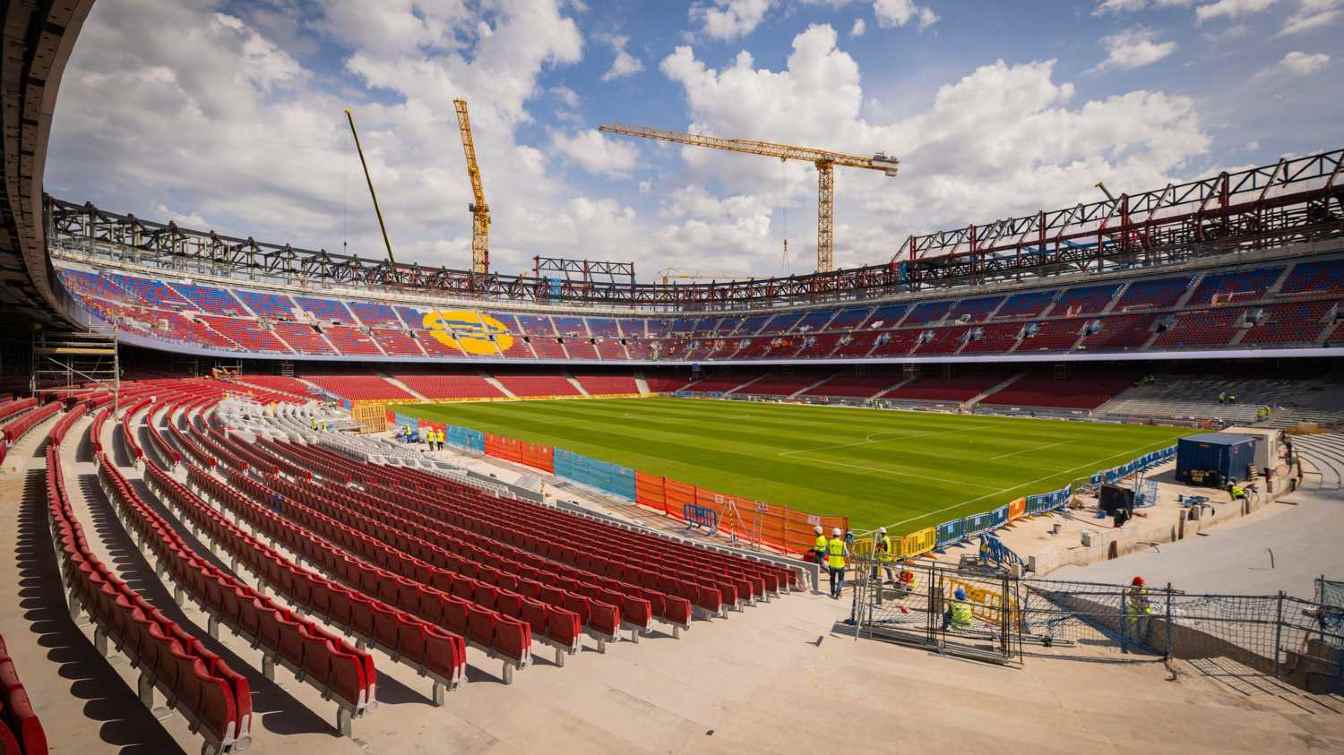 © Barcelona | Spotify Camp Nou (03.06.2025)
© Barcelona | Spotify Camp Nou (03.06.2025)
August 10? Another date, another twist
The announcement of Camp Nou’s reopening on August 10 was meant to be the finale of a long saga. The club released an emotional video, unveiled plans for the Gamper Trophy match, and launched a media campaign. But it quickly became clear that a crucial permit – the so-called occupancy license – was missing. The city emphasized that construction was not sufficiently advanced and that approval would not be granted. Despite club officials’ assurances that everything was under control, reality told a different story.
Barcelona was forced to move the match to Estadi Johan Cruyff, and the return to Les Corts was once again postponed. The new, more cautious date became the weekend of September 13–14, when Barça would face Valencia. This time, the goal was no longer a spectacular reopening, but rather a safe and gradual return – with a capacity of around 60,000 seats and construction work continuing on the remaining stands.
Although the club and city officially pledged to cooperate, tensions were noticeable. Laporta promised a quick return and stressed that the next phases of construction would be synchronized. He also admitted he was considering marking the reopening in a special way – as a tribute to Leo Messi. But even that gesture would have to wait, because until the stadium is at least partially completed, every new announcement remains just another wish.
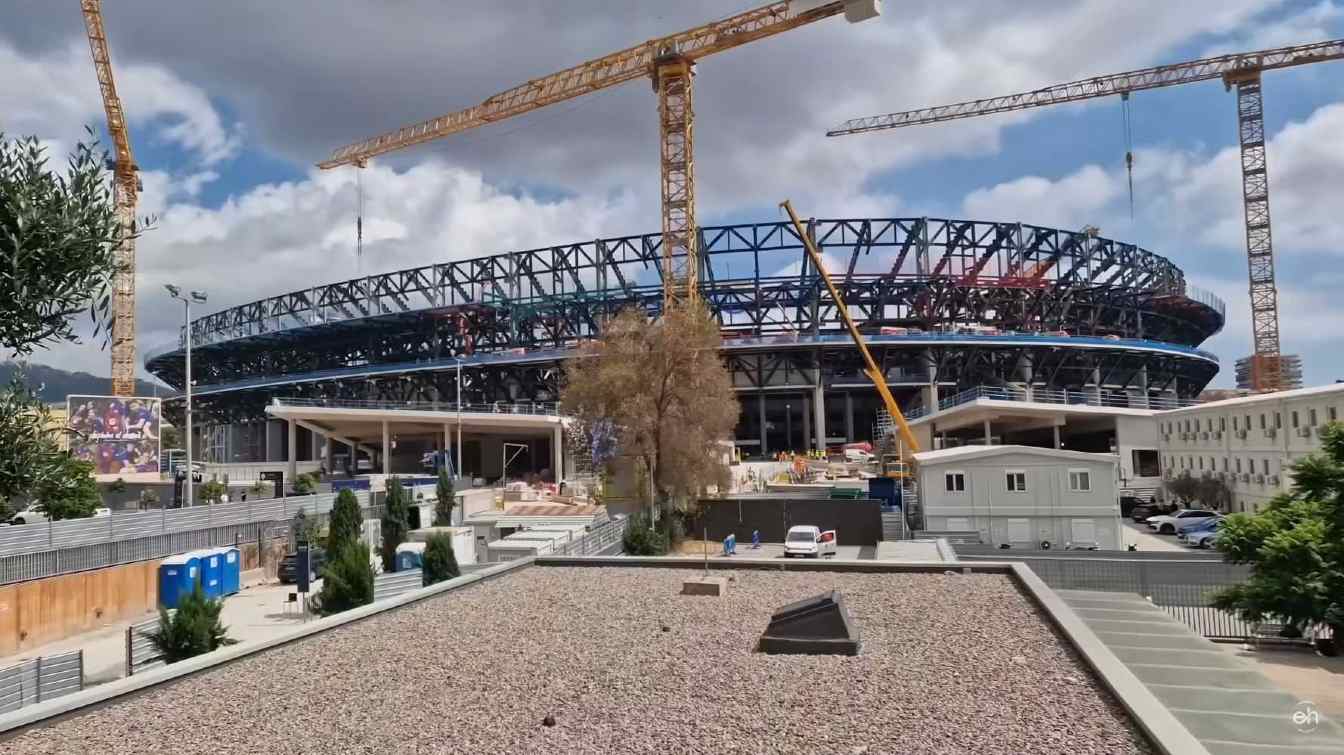 © Espai Héctor | Spotify Camp Nou (02.08.2025)
© Espai Héctor | Spotify Camp Nou (02.08.2025)
"I don’t know when, but as soon as possible"
In an interview with Mundo Deportivo at the end of July 2025, Joan Laporta attempted to explain why the return date of August 10 was announced even though a crucial permit had not yet been issued at the time. The president of FC Barcelona admitted that he was convinced all formalities would be completed in time, and said that the decision to announce the date stemmed from pressure and the need to inject urgency
into the project.
Laporta defended the collaboration with the City Council and assured that the actions of the club and the city were coordinated. He explained that the timeline had been divided into three sub-phases to ensure continued progress without further delays. He emphasized that the construction company Limak was operating efficiently and that the club had full confidence in the municipal authorities.
On the financial front, he left no room for doubt – the return to Camp Nou was essential for fulfilling the agreement with Goldman Sachs and other financial obligations, including the use of VIP boxes starting in January 2026. The alternative of remaining at Montjuïc was not an option due to its limited capacity and low revenue potential. We are not considering the possibility of not returning,
Laporta stated.
The president of FC Barcelona once again mentioned plans to honor Leo Messi, emphasizing that the ideal moment would be the official opening of the new Camp Nou. Such a match – featuring the Argentine legend – would symbolize the beginning of a new chapter for the club. As for when this saga will finally come to an end – that remains unpredictable. Not even Joan Laporta himself likely knows the answer, and after so many missed promises, it’s hard to believe in his latest declarations.
Advertisement
 StadiumDB
StadiumDB